
There seems to be some misinformation going around about what happened in Oakland over the weekend, specifically about the violence that occurred and who was responsible for initiating it.
I wasn't in Oakland for the festivities, but I did spend several hours watching video shot by OakFoSho (Spencer Mills) and OaktownPirate made available through UStream, as well as several others whose efforts were uploaded to YouTube. I've read quite a bit of first hand testimony. I have personal contacts in Oakland as well.
Occupy Oakland became the Energy Center for the Occupy Movement in the United States after the October 25, 2011 police assaults on their camp at City Hall and the subsequent fracas in the streets of Oakland that culminated in the firing of "less lethal" ordnance into a crowd demonstrators resulting in the severe wounding of Scott Olsen and the less severe wounding of hundreds of others. Ever since, what Occupy Oakland does has a profound ripple effect on the entire Movement.
Over the winter, I thought that Oakland might attract many cold climate activists and others to come to California and make Revolution. But that didn't seem to happen. Some came west, yes, but because the aktion in Oakland was something of the trigger for aktions against Occupy all across the country, climaxing with the violent eviction of the original Occupy Wall Street encampment in New York in November, local concerns seemed to be more pressing for many cold country occupations than heading out west. Meanwhile, Occupy Oakland had its own concerns and activities to deal with, including how to continue without an encampment.
Occupy appeared to go into hibernation over the winter, but that didn't mean there wasn't anything going on. Oakland continued to be a hotbed of radical and revolutionary thought and action, and on January 28, the public face of Occupy Oakland once again dominated headlines.
Activists set out to claim an abandoned public space, the Henry J. Kaiser Convention Center (known as the Oakland Auditorium in My Day), as the community and activity center for the Movement in Oakland. In this they were thwarted. I can't really say whether there was an expectation among the demonstrators that they wouldn't be thwarted, but if one doesn't take the chance, one can't know what will happen. I think they were prepared for pretty much any outcome.
The outcome that transpired, however, has been mischaracterized and propagandized as an example of how violent the Occupy Oakland people are, and how their violence is the reason they must be suppressed.
After all, a flag was burned at City Hall, right in front of the AP cameras, too. This shall not stand!
In fact, every bit of violence I witnessed in the hours of video I watched, that covered most of the activities and almost all of the violence that took place in association with Occupy Oakland on J28, was initiated by the police. ALL of it.
Over at Corrente, Lambert asserted two instances of "violence" by demonstrators who he said were dressed in black and threw bottles at the police line from the back of the crowd of demonstrators and this caused the police to "charge" the demonstrators. He offered no evidence or context, but he wondered if I approved or thought it was justified. Well, this is the kind of thing that has been cropping up repeatedly in internet discussions of what happened in Oakland, and from what I can tell, it appears to be based on the contrast between the main corps of believers in non-violence and the minority of mostly anarchists who appreciate diversity of tactics. Because there was a Black Bloc action in Oakland in conjunction with the November 2 General Strike in Oakland, in which a dozen or so windows were broken and some very spectacular graffiti was sprayed, there has been ongoing condemnation of Black Bloc tactics throughout the land and especially in Oakland, though generally it's put forth as condemnation of "anarchists," which is off-point. "Anarchists" are not all Black Bloc by any means.
But that's another topic. The topic here is the mischaracterization of the violence in Oakland over the weekend and how it has been propagandized as the work of Occupy Oakland when it was nothing of the kind.
At Corrente, I posted a play-by-play of OakFoSho's video document of what happened outside the Oakland Museum -- as an example of what the documentary evidence shows as compared to what the propagandists want you to believe.
Short version: No violence was initiated by the demonstrators. Every bit of it was initiated by the police, who repeatedly fired unprovoked on the crowd with flash-bang, smoke and tear gas grenades and with rubber bullets, firing directly into the crowd, injuring at least one person and probably more, and assaulting many others. This was not the first initiation of violence by the police that day. That happened at the Kaiser Center earlier when police fired smoke grenades into the crowd -- at least according to reports. I haven't seen video of that action, though I am sure it exists.
What follows is a slightly edited version of my play-by-play of OakFoSho's (Spencer Mills) video shot at the Museum.
I do not see evidence of the actions you describe in the videos I have seen of what happened in Oakland in front of the Museum or in front of the Kaiser Center or in front of the YMCA.
....
The only times I saw anything thrown at the police was after the police had fired on the crowd. And what I saw almost all looked like ordnance thrown back at the police that they themselves had fired at the crowd. Almost all of the things thrown at the police were thrown from well in front of the main body of the demonstrators, not the back.
A link: http://www.ustream.tv/recorded/20073032 About 14:00 in the police commence firing from their 10th Street formation at the corner of the Oakland Museum. The crowd is about 50 yards from the police line.
A vanguard of the crowd moves a bit closer to the police line following the initial volley of ordnance; they are kneeling on the pavement behind makeshift shields about 30 yards from the police line. The police fire again, directly at the demonstrators, hitting their shields as well as (apparently) some of the demonstrators. Flash-bangs and tear gas are fired directly into the crowd. At this point, the only things I saw thrown at the police were their own ordnance thrown back at them. After the second volley of flash-bangs, smoke grenades, tear gas and rubber bullets, most of the vanguard retreats. Flash-bangs and gas grenades continue to explode among them as they do. After another volley of rubber bullets, the shield bearers retreat. Nothing has been thrown at the police that I can see since the first volley. Then, after the crowd and the vanguard retreat, someone throws a garden chair toward the police. It lands ten yards or so from their line. At this point, the police line begins to break up because they are enveloped in their own tear gas. They pause in their assault to put on their gas masks.
More tear gas is fired at a demonstrator in a green jacket who is taunting the police. The main body of the crowd has retreated at least 100 yards from the police line. I don't see anyone throwing anything at this point, just shouting and taunting.
Once suitably masked, the police line somewhat haphazardly re-forms. The man in the green jacket keeps taunting them. No one is throwing anything that I can see. There is ordnance on the pavement, however.
A stand off ensues during which a man carried an upholstered chair along the sidewalk in front of the Museum and sits down within 10 yards of the police line. It sounds like he's saying something about the violence inherent in the system... He's sitting in his comfy chair and recording the action with his camera phone, possibly live streaming, but I don't know.
At this point, Spencer says "things are being thrown from the back now" -- but they don't show on the video, and he does not show where the crowd is at that point. They were at least 100 yards away from the police line. Spencer says he doesn't know what's being thrown, but it looks like it might be charcoal or a rubber bullet that was already fired (must not be bottles, eh?) and it isn't really reaching OPD. He doesn't show the crowd nor does anything that is thrown show on the video. He does show officers aiming their weapons at the crowd and announces their helmet numbers.
A man in a pink shirt approaches within about 20 yards of the police line and shouts "Cops go home, cops go home." Weapons are aimed at him by helmet numbers 160 and 079. It sounds like a round is fired, perhaps rubber bullet. There is someone on the pavement, looks like a woman holding her leg. The man in the pink shirt approaches her and bends down to speak to her. She lies down on the pavement. The man in the pink shirt stands over her. (Assuming it's a woman, not possible to tell for sure.) Several people on the periphery of the crowd are taking photographs of the person on the ground and showing a good deal of concern.
The crowd advances toward the police line, chanting "Cops go home, cops go home." The shield bearers crouch down about 40 or 50 yards from the police line. The crowd has thinned quite a bit, there may now be only half the number originally on Oak Street. The original number was impossible for me to judge because the video did not show the back of the crowd, but it was dense and filled the street.
Calls for a medic go out. The person lying on the pavement is injured. The shield bearers move forward and members of the crowd try to protect the apparently injured person lying on the pavement. One gestures to the police to stop firing. Shield bearers get between the injured person and the police line attempting to protect her(?) until medical aid can be summoned.
Something is thrown at the police line. It does not look like a bottle but rather a rubber bullet casing or a gas canister. The police fire at the crowd immediately. Canisters continue to be thrown back at them. Some land among the police.
The police are firing directly at the shields and the demonstrators.
It looks like more ordnance and possibly rocks are being thrown at the police while members of the crowd shout "Shame on you" at the police. They fire again, directly at the crowd -- which is now quite small. The crowd breaks and runs. Flash-bangs and tear gas are going off among them. Another call goes out for a medic. It's impossible to tell what has become of the injured person who the shield bearers had originally tried to protect. She(?) is no longer visible on the pavement. What's left of the crowd retreats, except for a couple of people who stay with one of the wheeled carts that are used as shields. One of those people taunts and curses the police as they charge up the street.
The police wheel the shield cart out of the way and begin shouting at and assaulting people on the sidewalks and the ramp of the Museum. It appears that those who don't get out of the way fast enough are being arrested unless they are "press."
The crowd has retreated to 11th St at least. The police line re-forms about midway between 10th and 11th St on Oak in front of the Museum. Indecipherable announcements are made over a loudspeaker while a helicopter buzzes overhead.
The man in the green jacket moves toward the police line and re-commences his taunts. Police run to grab him and hustle him behind their lines.
The demonstrators retreat down 11th Street headed toward downtown.
The confrontation in front of the Museum is over.
There's another hour or so of video on this segment but I don't have time to do more play by play today. You can watch it yourself and come to your own conclusions.
I would just say that in Oakland, throwing back ordnance that has been fired at non-violent demonstrators -- as was the case in this instance -- is justified. I did not see anyone in black throwing bottles at the police from behind the crowd. But if there had been someone doing that I would suspect a provocateur. A lousy one at that. The people I saw throwing things were at the front, not the back of the crowd, and they were throwing ordnance that had been fired at them without necessity or provocation.
The police did not charge in this instance because someone was throwing bottles at them, they charged when the crowd was thinned enough for their sense of safety.
If you saw people in black throwing bottles from behind the crowd and precipitating police charges on demonstrators, it would probably be good to cite the evidence, for that is not what happened in front of the Museum.
I would like to see evidence of any such action from behind the crowd. But so far... nada. That doesn't mean it didn't happen, in fact, I suspect it did. But if it did, it was not the proximate cause of the police charges at the Museum or nearby. In fact, I doubt it would have any effect on police action at all. Things were being thrown at the police to be sure, almost all of which appeared to be their own weaponry and ordnance. And everything that was thrown at the police -- that I saw -- was thrown AFTER the police fired on the demonstrators.
So what of non-violence?
Doesn't the principle of nonviolence require the demonstrators to "take their punishment" passively, kind of like the victims of the Amritsar Massacre of 1919? Isn't that how you WIN?
I heartily approve of non-violent tactics, they are very, very good and useful. I do not, however, condemn those who choose to defend themselves against the violence of the authorities. And what happened in Oakland, at least from what I saw and have read and heard was self-defense.
"Stand Up, Fight Back!" is one of the frequently heard chants of this Movement, one that you probably wouldn't have heard in Gandhi's day or Martin's; but you hear it now, all the time, and how some participants in this Movement are conducting themselves in confrontations with the police. They may not initiate violence, but they do not passively "take it."
Times have changed and the way forward is not the same as it once was.






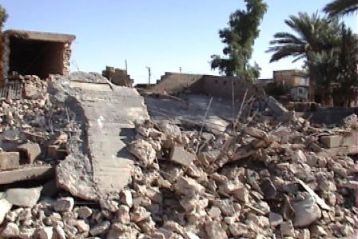 We had to postpone our trip to Al-Qaim and Haditha several times for 2 weeks. Many times the road was closed because of some military operations. We decided to go to the refugee camps first, be ready to move from there as soon as the road is clear. There were 8100 refugee families now (last time, before Oct 1, they were 7450) distributed on the nearest towns, villages and in the desert. Some of the camps were cut from any kind of relief, especially those which were across the Euphrates, because the American troops bombed all the bridges in Alqaim (3) and Haditha (2). The need now is for thick clothes, especially for children, blankets, and medicines for daily use, apart from food. The new families were those who escaped the latest attack on Alqaim (Oct1) and Haditha (Oct 5) The River’s Gate, as it was called. One of the biggest emergency relief organizations in Iraq now admitted that they can not reach the behind-the-river villages.
We had to postpone our trip to Al-Qaim and Haditha several times for 2 weeks. Many times the road was closed because of some military operations. We decided to go to the refugee camps first, be ready to move from there as soon as the road is clear. There were 8100 refugee families now (last time, before Oct 1, they were 7450) distributed on the nearest towns, villages and in the desert. Some of the camps were cut from any kind of relief, especially those which were across the Euphrates, because the American troops bombed all the bridges in Alqaim (3) and Haditha (2). The need now is for thick clothes, especially for children, blankets, and medicines for daily use, apart from food. The new families were those who escaped the latest attack on Alqaim (Oct1) and Haditha (Oct 5) The River’s Gate, as it was called. One of the biggest emergency relief organizations in Iraq now admitted that they can not reach the behind-the-river villages. 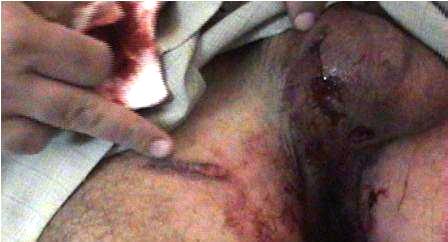 A young man, H.Khalaf, was lying on a trolley, soaked in blood. He was shot in his genitals by an American sniper while he was going home from the market just across the street. The shot injured his right thigh, his testes, and went out through his left thigh.
A young man, H.Khalaf, was lying on a trolley, soaked in blood. He was shot in his genitals by an American sniper while he was going home from the market just across the street. The shot injured his right thigh, his testes, and went out through his left thigh.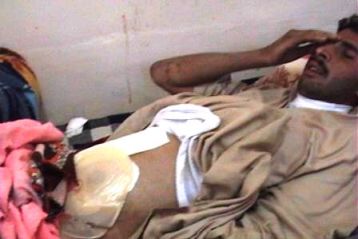 In the ward another young man, Salah Hamid, was shot under the belt too. He was driving his taxi at 10 am on Monday Oct17, 2005 in the market place when he was shot by the American snipers. Salah was so angry that he cried and used obscene words (unacceptable in those areas). His car was completely ruined. The doctor explained that a large part of his intestine had to be cut.
In the ward another young man, Salah Hamid, was shot under the belt too. He was driving his taxi at 10 am on Monday Oct17, 2005 in the market place when he was shot by the American snipers. Salah was so angry that he cried and used obscene words (unacceptable in those areas). His car was completely ruined. The doctor explained that a large part of his intestine had to be cut.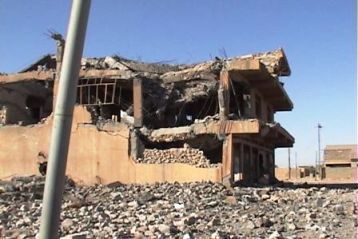

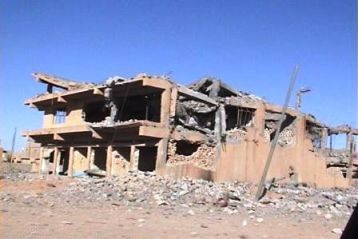
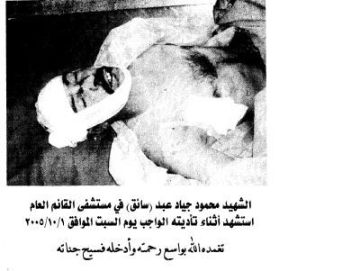 The ambulance driver, Mahmood Chiad, 35, was going to Karabla, to help some injured family during the attack. He was shot and killed by a bullet in the left chest. The ambulance was then hit by a grenade which ripped it in two parts, and burnt it. It was still there, but we could not film in the no man’s land, as they call it. Mahmood left a widow and six children; the oldest of them, Aimen (m), is 10 years old. “The family was not given any compensation or pension” said his colleague Muneer Said “he was very poor, living in a tin extension of a house, his family should be taken care of”.
The ambulance driver, Mahmood Chiad, 35, was going to Karabla, to help some injured family during the attack. He was shot and killed by a bullet in the left chest. The ambulance was then hit by a grenade which ripped it in two parts, and burnt it. It was still there, but we could not film in the no man’s land, as they call it. Mahmood left a widow and six children; the oldest of them, Aimen (m), is 10 years old. “The family was not given any compensation or pension” said his colleague Muneer Said “he was very poor, living in a tin extension of a house, his family should be taken care of”. 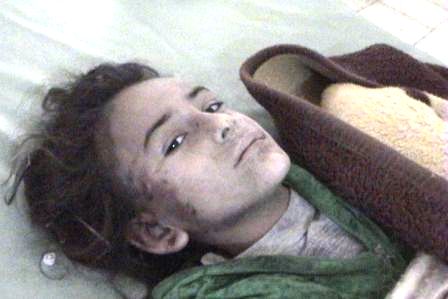 In the emergency ward, a girl of ten was lying on one trolley, and a young woman on another. They were still conscious. The girl, Yosr Jasim Mohammad Al-Ta’i, 10, (going to 5th grade, as she said proudly), was injured in her feet, back, and right ear, which were covered with blood. She did not know that she is the only survivor of a family of 8. Her father, her mother Ibtisam Thiyab Othman, and five of her brothers and sister were buried dead under the rubbles when the American airplanes bombed Al-Ish village at 2 am that day, Oct 26.2005.
In the emergency ward, a girl of ten was lying on one trolley, and a young woman on another. They were still conscious. The girl, Yosr Jasim Mohammad Al-Ta’i, 10, (going to 5th grade, as she said proudly), was injured in her feet, back, and right ear, which were covered with blood. She did not know that she is the only survivor of a family of 8. Her father, her mother Ibtisam Thiyab Othman, and five of her brothers and sister were buried dead under the rubbles when the American airplanes bombed Al-Ish village at 2 am that day, Oct 26.2005. 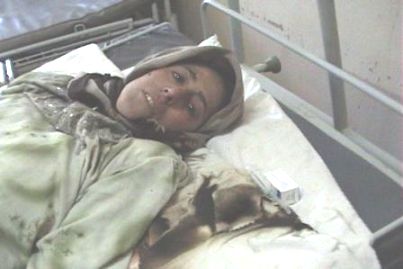
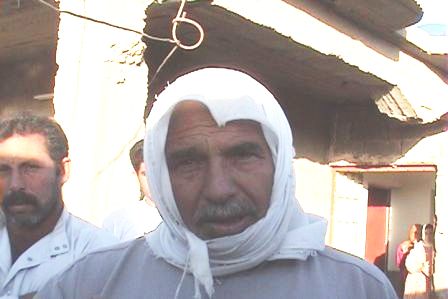 The first family was of Saggar Hamdan, a Land Cruiser driver who was taking his- and his brother in law’s- families to the Okashat refugee camp 200 kilometers away in the desert at 4 pm on the attack first day. His father explained that” there were 19 women and children in the car when it was shot and burnt by the American troops. Saggar , his wife Khadija, and his 6 children (Ala’(m)10, Adil (m), Omar(m), Sheima’(f), Lamia(f)’, and a baby) and his niece were killed. No one was allowed to approach the car until it was no more than ashes”. It was only after 5 days that a cousin, Hashim Hamid, was allowed to get the bodies.
The first family was of Saggar Hamdan, a Land Cruiser driver who was taking his- and his brother in law’s- families to the Okashat refugee camp 200 kilometers away in the desert at 4 pm on the attack first day. His father explained that” there were 19 women and children in the car when it was shot and burnt by the American troops. Saggar , his wife Khadija, and his 6 children (Ala’(m)10, Adil (m), Omar(m), Sheima’(f), Lamia(f)’, and a baby) and his niece were killed. No one was allowed to approach the car until it was no more than ashes”. It was only after 5 days that a cousin, Hashim Hamid, was allowed to get the bodies.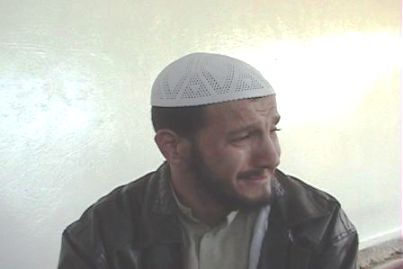 The second family was of Mohammad Jabir, a boy of nine years who was shot by an American sniper at his house door in the “Death Street” on Thursday Oct 20, 2005.
The second family was of Mohammad Jabir, a boy of nine years who was shot by an American sniper at his house door in the “Death Street” on Thursday Oct 20, 2005. 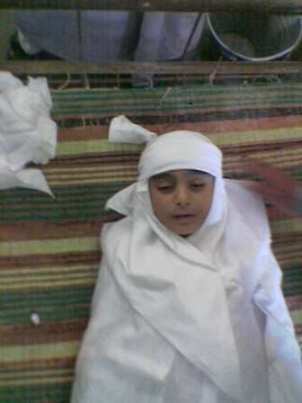

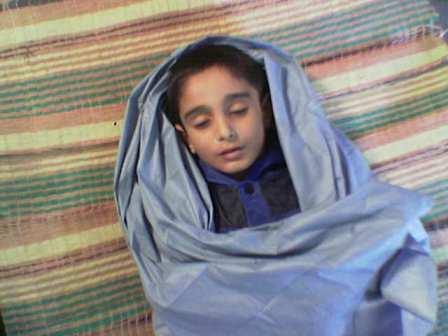
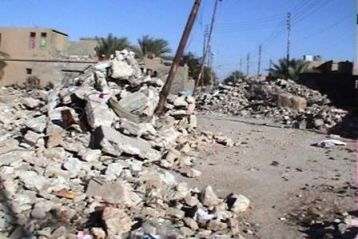 The third family was of Attiya Mikhlif. The house was no more than a heap of rubbles. It was bombed at 6 am on August 30, 2005. There was no one of the family left to tell the story. Neighbors were hesitant to talk. “The old man died years ago” one of the neighbors volunteered to talk at last. “There was his old wife, Dalla Hardan 55, his three sons, Daham 35, Rashid 25, and Salman 18, and two daughters in law: Rafaah 19 and Kholood 19. Rashid, his bride Rafaah, Salman and his bride Kholood were all newly married”. All of them were killed that morning.
The third family was of Attiya Mikhlif. The house was no more than a heap of rubbles. It was bombed at 6 am on August 30, 2005. There was no one of the family left to tell the story. Neighbors were hesitant to talk. “The old man died years ago” one of the neighbors volunteered to talk at last. “There was his old wife, Dalla Hardan 55, his three sons, Daham 35, Rashid 25, and Salman 18, and two daughters in law: Rafaah 19 and Kholood 19. Rashid, his bride Rafaah, Salman and his bride Kholood were all newly married”. All of them were killed that morning. 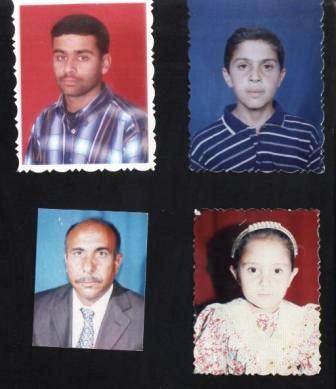
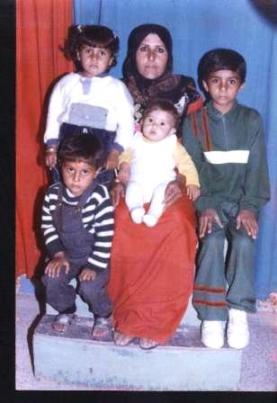
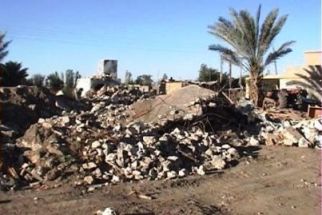

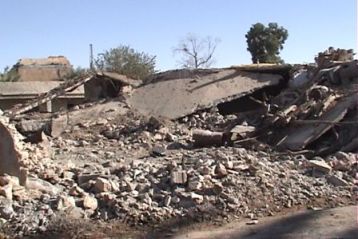 K
K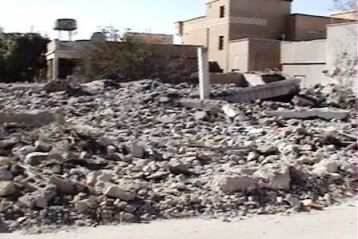 In
In 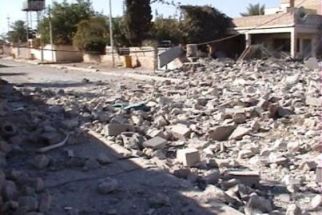 one of the houses in Al-Salaam district, Alwan Abdul Kareem refused to stay with his family in the refugee camp in Anah. He found it unbearable to live as a refugee, so he returned home alone 4 days later. The house was bombed on the same day (Oct 22), he was killed under the heavy stairs where he was hiding, eating his sohoor (the last meal before fasting). Alwan was 58, a gardener and a school guard. We met his family in Anah refugee camp. He left a wife Shokriya, 40, and eight children.
one of the houses in Al-Salaam district, Alwan Abdul Kareem refused to stay with his family in the refugee camp in Anah. He found it unbearable to live as a refugee, so he returned home alone 4 days later. The house was bombed on the same day (Oct 22), he was killed under the heavy stairs where he was hiding, eating his sohoor (the last meal before fasting). Alwan was 58, a gardener and a school guard. We met his family in Anah refugee camp. He left a wife Shokriya, 40, and eight children.